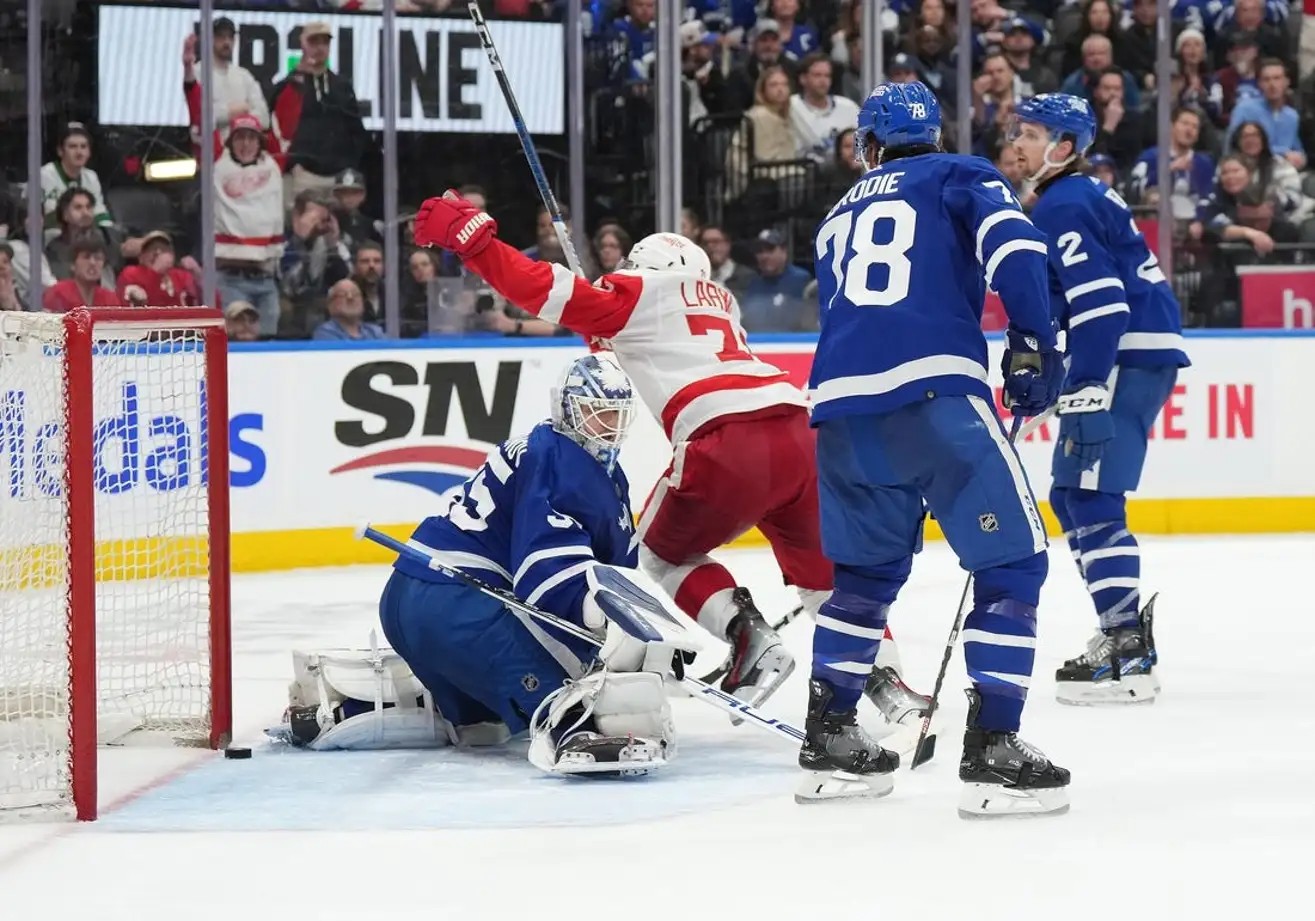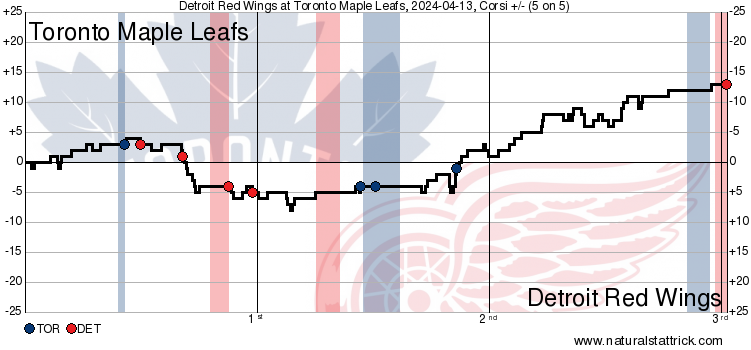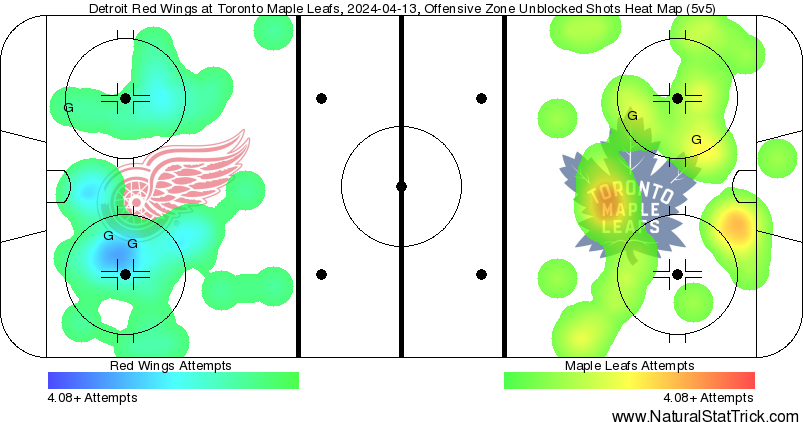Auston Matthews scored #69, but Maple the Leafs fell 5-4 in overtime to the Red Wings in a game that saw plenty of goals and a few injury scares.
The Leafs opened the scoring but then allowed four unanswered goals to close the first period, exhibiting a lack of defensive effort and (on one goal) woeful goaltending. However, they came out on fire in the second period and scored three to tie the game, including Matthews’ history-making goal. No one scored in the third before Detroit cashed in on an overtime power play to keep their playoff chase alive.
Your game in 10:
1. Both teams got a couple of looks early on in this game. The top line created a look for Tyler Bertuzzi that created a big rebound, but Detroit’s Ben Chiarot got the clear. Detroit’s fourth line created a look for Austin Czarnik that may have hit the side of the post. On Toronto’s top line’s next shift, Auston Matthews intercepted a loose puck in the offensive zone, came in tight on James Reimer, and flipped the puck off the crossbar.
Then came the first of several injury scares, on a rough hit from behind from Joe Veleno on Timothy Liljegren. The defenseman went hard into the boards as he was already hunched over to play the puck, drawing a boarding call that — much to Sheldon Keefe’s chagrin — was only a two-minute minor.
The Leafs didn’t get the call, but they did get the goal. Morgan Rielly passed it over to William Nylander, who slid down the right wing boards and uncorked a dagger pass diagonally across the seam. Mitch Marner received it on the backside and was staring at an open net after Reimer lost his footing in the crease. Marner fired it into the exposed net, putting his team ahead 1-0.
2. The Detroit response came pretty quickly, just over 90 seconds after Toronto got the scoring started. With the puck deep in the offensive zone, Morgan Rielly rolled the dice on an aggressive, low-percentage pinch. Up 1-0 and on the ice against a Red Wings unit containing dangerous scoring talent capable of striking quickly in transition, it wasn’t the time or place, and the decision backfired.
Dylan Larkin chipped the puck ahead to Lucas Raymond, who skated down ice on a 2v1 with Alex DeBrincat. TJ Brodie, once a master of the sliding dive to disrupt the pass and angle off the shot on odd-man rushes against, wasn’t able to cut this one out. Raymond snapped it across to DeBrincat, who tied it at 1-1.
3. Speaking of young Detroit Swedes taking advantage of defensive miscues from Toronto, the Red Wings took a 2-1 lead not long after from a great play by young defenseman Simon Edvinsson. The puck was in the Toronto end and a shot came in from Jeff Petry on the right side, wide of the net and rimming to the other wall. Edvinsson made a stellar read and pinched down to keep the puck in against William Nylander, ladling it down low to David Perron below the goal line. Perron took the puck and fed it right back to Edvinsson, who made a beeline to the net for his first-ever NHL goal that he shot directly into the net (Edvinsson scored two last season that were later credited to him off deflections by the opposing team).
Nylander got beaten by the pinch and then seemed to have his controller disconnect from the video game console, drifting aimlessly while Edvinsson made a cut to a dangerous area. This goal looked like one hungry team in a playoff chase playing another team with few stakes or reasons to compete. After a lapse in focus and intensity defensively, the Leafs were down 2-1.
4. The Red Wings weren’t done scoring in the first period. They went on a power play only a few minutes later when Matthew Knies got carried away pursuing Joe Veleno from behind, eventually getting his stick up on the hands and hauling Veleno down. This was a textbook bad penalty where Knies didn’t check with his feet and reached with his stick, leading to a hooking infraction in the offensive zone.
The Maple Leaf penalty kill started well; Jake McCabe used his stick well to disrupt one play and then block a shot, whittling the time remaining on the man advantage down. When Detroit’s second unit jumped on, David Kampf couldn’t seem to get a puck to settle down for him on the wall on what should’ve been a fairly straightforward clearance.
From there, the sticks and bodies of Simon Benoit and Ilya Lyubushkin couldn’t disrupt the down-low passing play to the bumper player, JT Compher. It created a rebound off the pad of Ilya Samsonov, who kicked the puck out and right to Alex DeBrincat for the 3-1 tally.
Just over two minutes later, with under 30 seconds remaining in the first period, it was Samsonov’s turn to wear the cone of shame on this one. Your author had just gotten done texting the sentence “even though three goals have gone in, I don’t blame Samsonov for any” when David Perron took a bad angle shot that somehow snuck through Samsonov. A goal reminiscent of several infamous goals allowed by Frederik Andersen in playoffs gone by, Samsonov seemed to be off balance and wasn’t tight to his post when Perron took the shot, after the puck was dug out by Patrick Kane.
Suddenly, it was 4-1 Detroit at the end of the first period due to four goals in under 10 minutes. At home this season, the Leafs allowed more goals per game than all but three other teams (worse than the Ducks at 3.4/game and easily the worst among playoff teams). That’s despite scoring first 24 times at home (top five in the league). Keefe’s comment after the game, “It seemed like one of those nights where our guys thought it was going to be easy,” is especially strange if true given the opponent had everything to play for tonight.
5. While some wondered if Keefe would pull Samsonov, he left the Russian in the net. In the second period, Samsonov didn’t have too much to do, making a confident save on another look for Edvinsson to get things going. He then helped kill off a second Detroit power play when Tyler Bertuzzi was whistled for high sticking in the offensive zone. The Red Wings didn’t get much on the net, and Simon Benoit showed out with one solid shot block as the visitors came up empty.
The Leafs were pretty lethargic through the first seven or so minutes of the second period. The Red Wings were defending well, and Toronto wasn’t able to get much on net and hadn’t made much of a charge. Then came the moment that opened the floodgates: a goal from Nick Robertson.
Robertson and Holmberg skated through the neutral zone on a 2v2 rush before Robertson perhaps used defenseman Olli Maatta as a bit of a screen, but this goal was mostly shooting talent. Robertson placed a great shot top corner past James Reimer’s glove.
Nicolas Robertson 14th of the Season vs Red Wings courtesy of Joe Bowen and Jim Ralph. #LeafsForever @Bonsie1951 @Jim_Ralph @LeafsJelly
4/13/2024 pic.twitter.com/dCQboWOMim
— Maple Leafs Hotstove (@LeafsNews) April 14, 2024
Robertson still has things to learn in the NHL, but there are a finite number of NHLers who can rip shots like that off the rush, and he is one of them. That’s not nothing in regard to playoff lineup considerations; it can change a game at any moment, and it did tonight.
6. Robertson’s goal made it 4-2 and cracked the door open for Toronto, helping them find some life. They also gained life from a dreadful penalty by Patrick Kane, who high sticked Benoit while in the Detroit offensive zone. The contact on Benoit drew blood, giving the Leafs a four-minute power play and a chance to use the 5v4 to erase the entire deficit.
James Reimer started the penalty kill for Detroit okay with a glove stop on Nylander, but then some pretty passing from Rielly, Marner, and Matthews created a goal that Reimer had little chance of stopping. The Leafs were snapping it back and forth, getting Reimer sliding around before Matthews’ wrist shot found the twine only 1:05 into the power play.
"IT NEVER SOUNDED SO SWEET!"
MATTHEWS 69th of the Season vs Red Wings courtesy of Joe Bowen and Jim Ralph. #LeafsForever @Bonsie1951 @Jim_Ralph @LeafsJelly
4/13/2024 pic.twitter.com/ffTzZsYGGT
— Maple Leafs Hotstove (@LeafsNews) April 14, 2024
Matthews’ goal is his 69th of the season, continuing a historic campaign that has no parallel in the 21st century. It kicked off a palpable buzz in the building whenever Matthews touched the puck in anticipation of #70.
The second unit started the second half of the man advantage before the top unit came back out, and Matthews uncorked a barrage of shots. In total, the Leafs took nine shots on goal in the ~three minutes of 5v4 time. They couldn’t score the equalizer, but these were encouraging signs from the power play as it looks to regain momentum ahead of the playoffs.
7. Unfortunately, here we should talk about the injury storylines. Two concerning developments unfolded in the span of a few minutes from the Leafs’ perspective. While the PP was still going, Matthews got a look in tight for #70 but was stopped by James Reimer. Afterward, Matthews was skated into by friendly fire, losing his balance and tumbling hard into the end boards. He got up slowly and continued to play, but much of Leafs Nation was holding their breath at that moment.
When the play returned to five aside, the Red Wings had the puck in the offensive zone, finding Dylan Larkin in the slot. Jake McCabe, as he so often does, played completely fearlessly, tossing himself in front of the shot and taking it off the face, bleeding profusely as a result.
On top of all it, there was an injury I didn’t mention early on to Bobby McMann, who got tangled up in the corner and then went off the ice. This one might prove to be the most concerning. Post game, it was determined to be a lower-body injury that needs further evaluation. McMann has emerged as a key cog on the top-nine LW not just offensively but arguably as their best option defensively at the position as well — a big piece of giving their balanced look up front more credibility ahead of the playoffs.
8. The Leafs tied up the contest before the second period was even up. They embarked on a dominant cycle shift that had the Red Wings on their heels — the second line of Knies, Marner, and John Tavares were buzzing in the offensive zone. They took several shots on Reimer and retrieved each one until, eventually, Marner fed Tavares in the slot, who ripped a shot over a sprawling Mortiz Seider and past Reimer.
From the moment the Robertson goal went in, the Leafs were all over the Red Wings to close the second period. Each shift was tilted in Toronto’s direction, and you could feel that tying goal coming. Marner’s playmaking and Tavares’ finishing converted on it, and the two teams headed to the dressing room tied at 4-4.
We mentioned the concerning statistics on home ice this season, especially compared to past seasons. A stat that remains encouraging with this Leafs team is its dominance in the second period with the long change. After tonight, the Leafs lead the entire NHL with 114 goals in the middle frame.
9. During the second intermission, it was revealed that due to other results across the NHL, the Red Wings needed at least one point out of this game to avoid mathematical elimination from the playoff picture. A game that already had immense stakes for Detroit saw those stakes and intensity turned up to 100, and you could tell in the third period how focused the Red Wings were on defending, desperate to, at the very least, preserve the point.
The third period wasn’t the most high event period — certainly not in comparison to the first two. Matthews got a few solid looks, including putting a tip wide, and Knies dangled through Detroit bodies before shooting into Reimer’s glove. Nylander got a good look that Reimer also stopped with the glove as the one-time Leaf played a strong third period in the Detroit net. Contrary to the first period (and most of his season), Reimer was poised, composed, and quiet with his movements, affording few rebounds.
In the other net, Ilya Samsonov wasn’t asked to do a ton, but he did make one game-saving stop. The tandem of Dylan Larkin and Lucas Raymond, Detroit’s two best offensive players, hooked up to create a point-blank look in front off a pass from behind the cage. Samsonov stood his ground and made a big reflex save, one that kept the game tied. This was an important bounce-back moment after the four-goal first period, which came in the wake of six goals on 20 shots vs. New Jersey.
With under four minutes to go in the game, Patrick Kane took another terrible high-sticking penalty, this time in the neutral zone, that gave the Leafs a late power play to put it away (to no avail). I didn’t think this was a poor process on the power play in any way — Toronto was able to keep the zone and create several excellent looks, including a tip by Tavares off a Marner pass and a Nylander one-timer from the wing.
10. The Toronto power play came up empty due to Reimer, and it expired with under a minute left in regulation. As the Red Wings came skating through the center ice area Max Domi got the stick in on Alex DeBrincat, who went down and drew the tripping call. The Leafs were shorthanded with 10.4 seconds left in regulation, and the Wings managed to create a mad scramble in the goalmouth, but Samsonov secured the puck and guaranteed Toronto at least a point.
Of course, there was a significant carryover on the power play into overtime, where 4v3 power plays are as dangerous as they come. TJ Brodie touched the puck while shorthanded but sent it into the corner over attempting to clear down the ice. Shayne Gostisbehere handed it off to Kane, who skated down the wall and passed it through Benoit to Dylan Larkin, who established positioning on Brodie in front for the game-winner.
The Leafs got about what they deserved in this one—one loser point—for showing up a period late urgency-wise against a desperate Detroit team before taking the game more seriously in the second and third periods. Dropped points at home to division opponents below them in the standings have been a frustrating feature of the Leafs’ season, but third place was all but set in stone before this game. Most concerning and relevant are the injury developments, particularly with McMann and McCabe (the latter’s situation sounds more encouraging than the former’s).
Liljegren, Rielly, and Matthews may have picked up a few bumps and bruises in the game, which only brings load-management considerations more sharply into focus heading into the season-closing back-to-back in Florida. The Leafs do have to abide by the rules of the cap and need to ice a full roster for two more games — there is only so much resting they can do — so let’s hope this is the last of the ill-timed, late-season injury scares.
































![New Leaf Anthony Stolarz on the opportunity in Toronto: “In Florida, I knew my role as a backup… Now, [Joseph Woll] and I are competing for starts… As a goalie, that’s all you can ask for” Anthony Stolarz, Stanley Cup win, now Maple Leaf](https://mapleleafshotstove.com/wp-content/uploads/2024/07/anthony-stolarz-sc-100x70.jpg)
